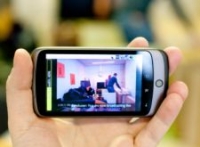Set in 2054 the movie Minority Report had Tom Cruise using the iconic "gesture interface", waving his hands and sending images winging through the air. Since then technology has advanced rapidly, for example, swiping a screen has become a natural thing to do and the idea that any surface can be a screen is no longer unimaginable.
To illustrate how quickly the
technology is developing LG recently showed a 64 inch screen at CES 2017 called Wallpaper and now they have one that comes in at just 1mm thick and can be attached to a wall with
magnets. This is perfect for business presentations. How recently would a
screen that can be rolled up like a sheet of paper have seemed like science fiction?
So, it seems all the parts are there - a screen, or something plugged into it that can display images or video that it gets from somewhere else, a device in your hand, or in your lap, that gives you instant feedback the moment you touch or slide your finger across it, and a wifi network in your office that connects it all up.
But there is one major hurdle stopping you from sharing media across all of these screens and devices: TVs, smartphones, tablets, and smartwatches are made by so many manufacturers. Some have features which allow ‘cross-device' compatibility. This means you can send a video from your Samsung phone to your Samsung TV, or use Airdrop to send photos between Apple devices. ‘Cross-manufacturer' compatibility has not yet arrived.
There are hardware solutions but all these require the app, or an extension to the app, to be compatible with your content (e.g. like Chromecast, Roku, Fire TV, and Apple TV).
Standards are slowly being developed: Samsung's Tizen system supports various types of DLNA, Miracast and DiAL screen sharing protocols across their range, LG have utilise both WebOS and Netcast, and Sony are producing their own platform, as well as a Google TV variant. On top of that you have Amazon's Fire TV, Google's Chromecast, Roku, Apple TV, and a other generic TV plug-in sticks and boxes. However these solutions are not independent and fail to put the user at the centre. What's needed is tech that centres the media experience on users and their most familiar computer interface.
This is where the new kid on the block, Playora comes in. The basis of this new technology and app is that it gives the user the ability to touch something on one screen, and have it appear on another screen without fuss, wires or layers of menus. And that screen doesn't even have to be the same county or country!
Picture this scene: you've organised a great event for the business, it went with a bang and now you want to leverage it by sharing the images and building on the goodwill you created - but your guests all have different makes and models of phones, tablets, laptops and Smart TVs... not a problem: you just open up Playora! Swipe, press, swipe, press... voila! It's on all their screens at the same time - and the comments are going crazy!
Who knows where we go next! With Google recently filing a patent to the US Patent & Trademark Office for what they are calling an "intra-ocular device" that lens may one day become a tiny, injectable transparent screen that lives in your eye and is connected to your phone by Bluetooth - making it possible to share your photos and videos directly into someone's eyes, essentially creating a personal 3D cinema and built in virtual reality unit all in one, leaving Minority Report to dust!
Want to get involved?
Playora is raising £300,000 crowdfunding right now on Crowdcube, check out our pitch and see how you can buy a chunk of equity in the company that's making science fiction science fact: https://www.crowdcube.com/playora






